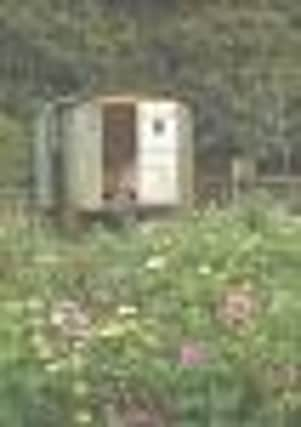Rare plants such as the fuchsia Californica were just one of the reasons why being able to buy Redcliff garden, in East Lothian, was for Joe and Jenny Harper a dream come true


Set in rolling countryside between Traprain Law and the Lammermuir Hills, the Victorian house overlooks a sloping garden with views over the Whittingehame Burn at the foot of the hill and the countryside beyond. Even more important for a passionate gardener, the framework of the garden, the terraces and paths that make sense of a challenging site, were in place.
“The garden belonged to Garth and Valerie Ramsay,” Jenny says. “Garth was a keen landscaper who built the terraces and paths, and installed strategically placed stand pipes. He was a keen gardener and plantsman, always sourcing plants from unusual places. We loved coming here and seeing the grounds. When they moved to France we were able to buy it.”
Advertisement
Hide AdAdvertisement
Hide AdGarth also left a detailed inventory of his plants; an invaluable reference detailing such rare delights as Zauschneria Californica, the Californian fuchsia that brightens the first terrace below the house.


For Jenny, the chance to develop the garden, “taking it a stage further, building on the magic Garth had started to introduce”, was a dream come true. To the landscape gardener – she started Growing Gardens 14 years ago around a kitchen table during school hours with Linda Shaw Stewart, and it has now expanded from “a trailer and a Land Rover” to a skilled team of five – Redcliff represented the chance to experiment with her own ideas.
There was plenty of opportunity. Loosely divided into different spaces, the garden’s four acres expand from formal box-enclosed areas close to the house, to informal areas further away. This skilful blend of formal and informal is perhaps most keenly felt in the box garden that leads out from the kitchen via the sunny, west-facing terrace. Here, Jenny expanded on Garth Ramsay’s original layout of box-edged beds punctuated with pyramids, using it to contain an exuberant collection of silver and white plants, including roses. All shrubs, including her favourite Viburnum carlesii, “chosen for its scented early spring flowers”, are under-planted with clematis for extended interest.
An arch in the hedge leads you across the drive towards a set of steps, flanked with vintage wooden obelisks and Rosa ‘Iceberg’ underplanted with purple-flowering Nepeta ‘Six Hedge Giant’ that lead down the slope. Here, your eye is drawn up, over the woodland garden and the Whittingehame Water towards the Lammermuir foothills.
A left turn leads past the house, where in autumn, pink-tinged Hydrangea paniculata ‘Grandiflora’ takes centre stage, past the open lawn backed by the original stable walls, host to Jenny’s favourite, scented, climbing rose ‘Crème de la Crème’, still in full bloom. Opposite is the charming focal point of an octagonal summer house, which turns on its axis to catch the sun, and views of the garden and countryside. Continue on past a newly planted orchard to trees, the house, and towards the vegetable garden. Here, the perfectly proportioned gravel paths that divide the beds are neatly lined with herringbone brick. “I am a stickler for proportion,” Jenny says. “Width of path, steps, terraces, proportions of pergolas, trees and shrubs all have to be looked at in proportion to the house. I’m fascinated by the way it makes a difference to a garden. If you get it wrong, it just doesn’t work.”


It is a small point that is perfectly illustrated in the curving grass path that leads down the hill, wide enough for two people to walk comfortably side by side. Taking you past newly planted sorbus, acers, claret-tinted shrubs and a cheerful patch of deep pink Japonica Pamina, it runs down to the bridge across the river towards a glorious wildflower meadow.
Presided over by a charming rustic shepherd’s hut, carefully positioned to catch the evening sun, this newly established meadow remains in October a glorious tapestry of colour lit by swathes of pink and white cosmos. Explaining that it took time to establish the wildflowers, find the right mix of annual seeds – this one includes scarlet poppies, tiny blue and maroon cornflowers – and to learn how to keep the weeds down, Jenny says: “We leave the meadow standing during the winter for the wildlife, and rotivate and sow afresh with a special mix in the spring.”
Wandering back along the lower path she enthuses about ideas for a bluebell wood above the river, and explains how she underplants areas of wild grass and just about everything else with bulbs. This point is reinforced in the Woodland Garden where a group of hostas, underplanted with white alliums, produced a show stopping display on the opening day under Scotland’s Gardens Scheme, and where bright pink nerines and a swathe of alstroemeria illuminate soft autumn hues.
Advertisement
Hide AdAdvertisement
Hide AdThe couple, who tend the garden alone with occasional help from the Growing Gardens team during the quieter months of the year, claim “it is not immaculate but that the most important thing is sitting in it, eating in it, having places to enjoy with family and friends. If it happens to be nice enough to sit outside and have a picnic, then do it”.
• Growing Gardens ([email protected]; 01368 850210; 07989 163369)